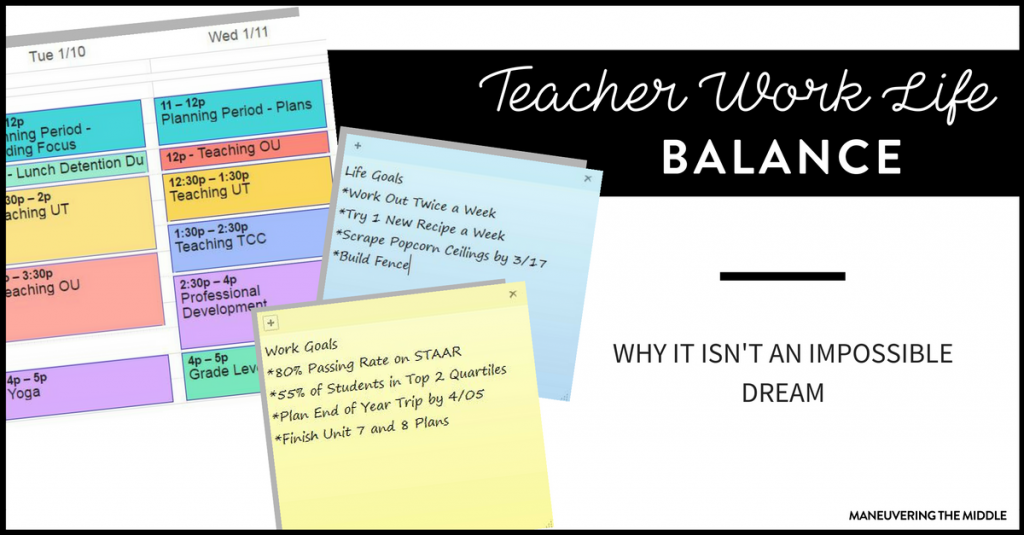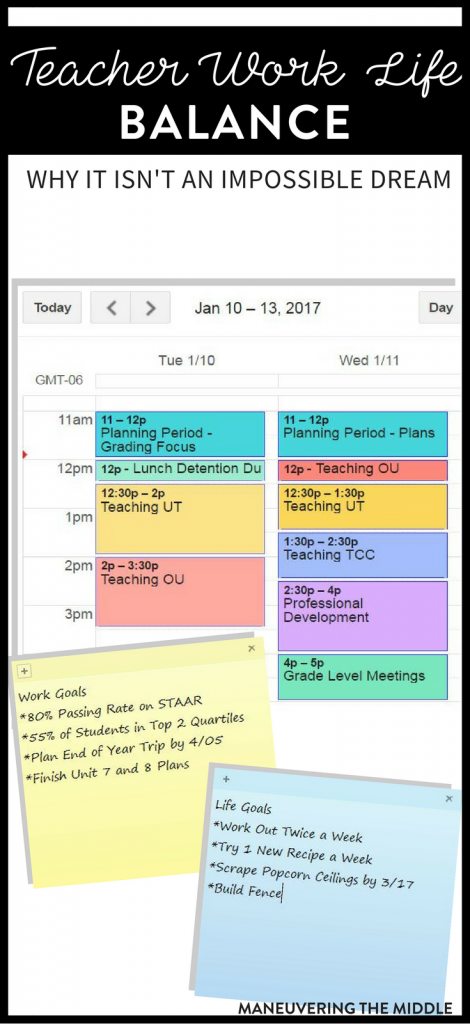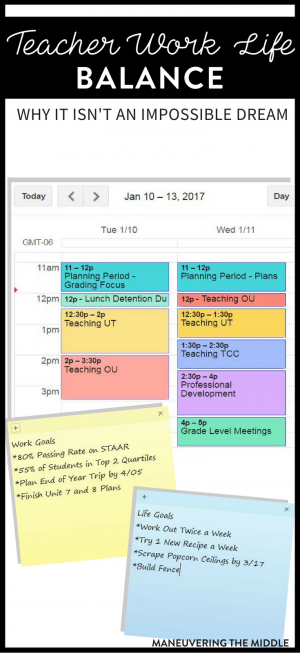Work. Life. Balance. Those three words are the pinnacle of what all teachers hope for. If you are a first year teacher, you are probably consumed by the “work” piece. If you are a teacher with kids, you are probably consumed with the “life” of you and your family.
The best analogy I have heard lately about work-life balance is to think of it as a pendulum. At various points throughout your career you will be more consumed by work than life and vice versa. The true challenge is to recognize that there is no perfect solution, but if you aren’t striving to maintain a balance it is easy to be consumed 24/7 by teaching.
These four strategies have been helpful as I have struggled to attain a happy medium between the two.
 Work life balance for teachers
Work life balance for teachers
1. Make the Most of Your Work Time
The bell has rung, students are dismissed, and you are exhausted whether it be the end of the day or the start of your planning period. You putter around your classroom aimlessly or chat with your coworkers! We have all been there.
To combat this waste of time, have a plan for your planning period. Sit down and make a to do list of what you need to complete before your next class.
I assign a task for every day, so that I can maximize my time.
- Mondays – Grading (because grades are due on Tuesday)
- Tuesday – Planning for the next week
- Wednesday – Answer keys for what I planned
- Thursday – Copies for the next week
- Friday – Everything else/other deadlines
Additionally, know your most productive times and maximize what you can get accomplished. I leave my most mindless tasks for the end of the day because my brain is fried. I am the most fresh in the morning, so that is when I knock out my planning.
2. Make Life a Priority
If you keep bringing your work home, you will keep doing work at home. I know that I work much slower at home.
Grading in front of the TV? That’s a great way to make a 30 minute grading task turn into a 3 hour grading task. At home, you are distracted and things take 10 times longer.
Yes, it is nicer to be in the comfort of your home, but home should be for relaxing. Don’t leave school until you have accomplished everything you need for the next day. If you are tempted to work at home, then leave your laptop at school.
My first year of teaching I chose to work when I was home because it gave me a sense of control in a chaotic year. I “worked” but did not accomplish much of anything.
I was not making life outside of school a priority. I was too busy (with school) and too tired to make any commitments to my social life or health. It wasn’t until I joined a small group and made some friends that I began to put restraints on my time spent working.
3. Say No Thank You
This month’s Real Simple magazine’s front cover broaches this topic. Saying no or simply not volunteering to do more work when it is presented is challenging. We feel bad and just want to help. Plus, there is always a need for a committee leader, team leader, field trip organizer, etc.
Saying no is perfectly healthy because it means you have boundaries. If you want to maintain balance in your work and your life, then you must be comfortable saying no. You shouldn’t say no to everything, but before you say yes, evaluate your schedule and circumstances.
“I can’t help with _________ right now, but please ask me next time you need __________.”
I recently heard a statement that really resonated. “No is a complete sentence”. So, often we feel this need to justify our response.
Sometimes, “No, thank you. I appreciate you thinking of me” is a perfectly acceptable response.
4. Understand that the balance will take time
This is my fifth year as a teacher, and the first year that I have not brought any work home. Over time you become more comfortable with your curriculum, the processes at your school, and more confident in your classroom management, which all save you time and energy.
According to this Washington Post article, teachers spend on average 53 hours a week working. There was a time when I would have said that 53 hours seems like a vacation!
You will not achieve balance if you don’t even know how much time you are spent working to begin with. Like someone who is trying to lose weight, start tracking how much time you are working daily. Make it a goal to work a little bit less each week.
I use timers for my students to move faster, and it has the same effect for me too. I set my timer for any task if I want to stay focused, and it keeps me motivated to finish.
Whether you are in your first or twentieth year, in order to have balance, you must be taking steps to in the direction of balance. To start off the new year, commit to spending a couple hours less working in each week. You can do it!



Great tips and advice. I like the tasks for each day of the week.
Thank you! It helps to divide everything up for sure and not feel so overwhelmed.
Thank you for this information, I have been truly struggling with the balance piece this year. I feel like my family life is sacrificed for my school life. Teaching is a 24/7 job, but so is being a wife and mother.
Yes, Heather! I didn’t know how crazy life was until I had my son. So true!
I am experiencing something like this
Just know that you are not alone. Hope you have a great second semester and are able to implement a few things to find more balance. 🙂
I am a student studying education, and your blog makes me so excited and also helps me to mentally get ready for one day when I do face the class room.
Thanks so much! I am glad you have found the blog helpful!
I have maybe a silly question. There is a pic that accompanies this post for the Teacher Work Life Balance and it shows a sample schedule. Is this a real app or program that I could download. I like this format and simplicity. I don’t want to put a ton of time into creating one. I don’t really want to use Google because I already have to manage about 4 of those and while somewhat convenient I want a sort of check list type list.
Thanks!
I was hoping to see the schedule in the pic too.
How do you only spend one planning period a week on grading? I teach high school French and history, with 140 students in total. I spend at least 5 hours a week grading student work! In one hour per week, I could barely look at all the work my students complete, let alone provide high-quality feedback and enter the grades online. What is your secret??
Hi, Maggie! When I taught social studies, I definitely spent more time grading. I really try my hardest to provide feedback to my students in class. This post has more information https://www.maneuveringthemiddle.com/more-feedback-less-grading/